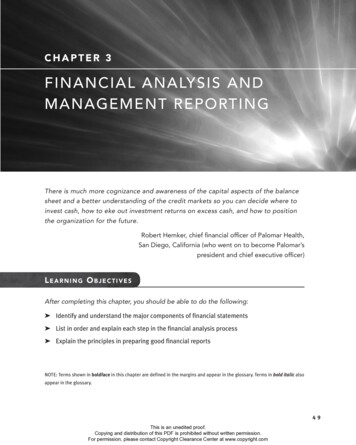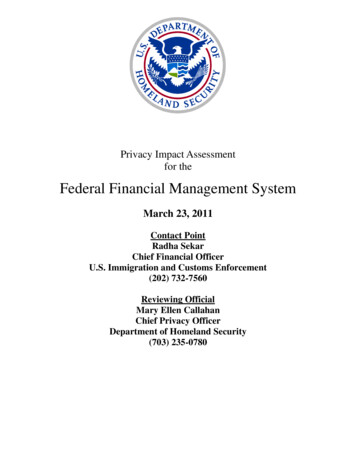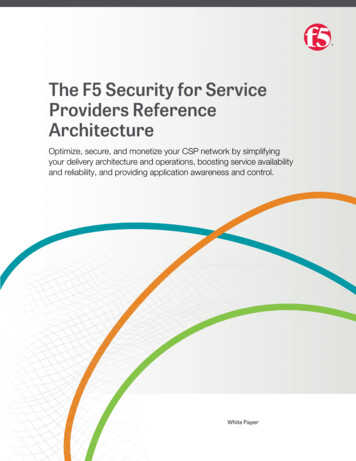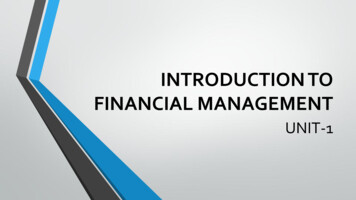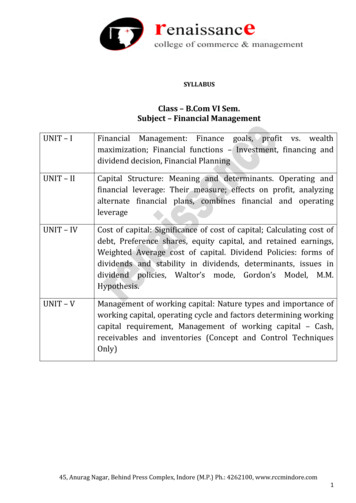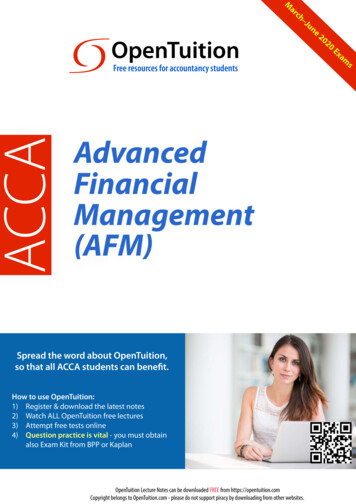
Transcription
MACCAOarch–JuOpenTuitionFree resources for accountancy studentsAdvancedFinancialManagement(AFM)Spread the word about OpenTuition,so that all ACCA students can benefit.How to use OpenTuition:1) Register & download the latest notes2) Watch ALL OpenTuition free lectures3) Attempt free tests online4) Question practice is vital - you must obtainalso Exam Kit from BPP or KaplanOpenTuition Lecture Notes can be downloaded FREE from https://opentuition.comCopyright belongs to OpenTuition.com - please do not support piracy by downloading from other websites.ne2020Exams
The best thingsin life are freeIMPORTANT!!! PLEASE READ CAREFULLYTo benefit from these notes you must watch the free lectures on theOpenTuition website in which we explain and expand on the topics covered.In addition question practice is vital!!You must obtain a current edition of a Revision / Exam Kit. It contains a greatnumber of exam standard questions (and answers) to practice on.If you order on line, you can buy study materials from BPP with our 20%discount code: bppacca20optu17You should also use the free “Online Multiple Choice Tests” which you can findon the OpenTuition website:https://opentuition.com/acca/
March-June 2020 AFM ExamsWatch free ACCA AFM lectures1Advanced Financial Management (AFM)1.Objectives of Organisations92.Conflicts of Interest and Their Resolution113.Strategy Formulation134.Corporate Dividend Policy195.Behavioural Finance216.The Cost of Capital237.Portfolio Theory298.The Capital Asset Pricing Model319.Discounted Cash Flow Techniques3710.Risk and Uncertainty4511.The Valuation of Debt Finance, the Macaulay Duration and the Modified Duration4912.The Impact of Financing5513.Share Options and Option Pricing5914.Real Options6715.Mergers and Acquisitions6916.The Valuation of Acquisitions and Mergers7317.Corporate Reorganisation and Capital Reconstruction Schemes8118.Foreign Exchange Risk Management (1)8519.Foreign Exchange Risk Management (2)9520.Interest Rate Risk Management (1)9921.Interest Rate Risk Management (2)10722.Exchange Rate Determination10923.International Operations11324.Sources of finance – Islamic Finance11525.Financial Management Terms11726.Answers to Examples123Only on OpenTuition you can find: Free ACCA notes Free ACCA lectures Free ACCA tests Free ACCA tutor support The largest ACCA community
March-June 2020 AFM ExamsWatch free ACCA AFM lectures2Access FREE ACCA AFMonline resources on OpenTuition:AFM Lectures (complete course)To fully benefit from these notes you should watch our free AFM lecturesAFM Revision LecturesWatch our AFM revision lectures working through the past ACCA examquestionsACCA AFM ForumsGet help from other studentsAsk AFM TutorPost questions to a ACCA tutorvisit https://opentuition.com/acca/afm/Only on OpenTuition you can find: Free ACCA notes Free ACCA lectures Free ACCA tests Free ACCA tutor support The largest ACCA community
March-June 2020 AFM ExamsWatch free ACCA AFM lectures3FormulaeModigliani and Miller Proposition 2 (with tax)k e kie (1 – T)(kie – k d )VdVeThe Capital Asset Pricing ModelE(ri ) Rf βi (E(rm ) – Rf )The asset beta formula V (1 – T)Vedβa βe βd (Ve Vd (1 – T)) (Ve Vd (1 – T)) The Growth ModelPo Do (1 g)(re – g)Gordon’s growth approximationg breThe weighted average cost of capital V V WACC e k e d k d (1 – T) Ve Vd Ve Vd The Fisher formula(1 i) (1 r)(1 h)Purchasing power parity and interest rate parityS1 S0 x(1 hc )F0 S0 x(1 hb )(1 ic )(1 ib )10Only on OpenTuition you can find: Free ACCA notes Free ACCA lectures Free ACCA tests Free ACCA tutor support The largest ACCA community
March-June 2020 AFM ExamsWatch free ACCA AFM lectures4Modified Internal Rate of Return1 PV nMIRR R 1 re – 1 PVI ()The Black-Scholes option pricing modelc PaN(d1) – PeN(d2 )e –rtWhere:d1 ln(Pa / Pe ) (r 0.5s2 )ts td2 d1 – s tThe Put Call Parity relationshipp c – Pa Pee –rt11[P.T.O.Only on OpenTuition you can find: Free ACCA notes Free ACCA lectures Free ACCA tests Free ACCA tutor support The largest ACCA community
March-June 2020 AFM ExamsWatch free ACCA AFM lectures5Present Value TablePresent value of 1 i.e. (1 r)–nWherer discount raten number of periods until paymentDiscount rate 512Only on OpenTuition you can find: Free ACCA notes Free ACCA lectures Free ACCA tests Free ACCA tutor support The largest ACCA community
March-June 2020 AFM ExamsWatch free ACCA AFM lectures6Annuity Table– (1 r)–nPresent value of an annuity of 1 i.e. 1————––rWherer discount raten number of periodsDiscount rate 4·675111213141513[P.T.O.Only on OpenTuition you can find: Free ACCA notes Free ACCA lectures Free ACCA tests Free ACCA tutor support The largest ACCA community
March-June 2020 AFM ExamsWatch free ACCA AFM lectures7Standard normal distribution his table can be used to calculate N(d), the cumulative normal distribution functions needed for the Black-Scholes modelof option pricing. If di 0, add 0·5 to the relevant number above. If di 0, subtract the relevant number above from 0·5.End of Question Paper14Only on OpenTuition you can find: Free ACCA notes Free ACCA lectures Free ACCA tests Free ACCA tutor support The largest ACCA community
March-June 2020 AFM ExamsWatch free ACCA AFM lectures8Only on OpenTuition you can find: Free ACCA notes Free ACCA lectures Free ACCA tests Free ACCA tutor support The largest ACCA community
March-June 2020 AFM ExamsWatch free ACCA AFM lectures9Chapter 1OBJECTIVES OF ORGANISATIONS1. IntroductionThe purpose of this chapter is to introduce the framework within which financial managersoperate, and to identify the main areas where they have to make decisions (and also you, in theexamination!).2. StakeholdersThere are many types of organisations and many different groups that have a stake in theperformance of the organisations.2.1. These groups include:๏Shareholders๏The community at large (in particular, environmental considerations)๏Employees of the company๏Managers / directors of the company๏Customers๏Suppliers๏Finance providers (lenders)๏The governmentThe interests of all stakeholders need to be balanced.In the UK (and the USA) the focus is on the shareholders, on the basis that it is the shareholders thathave a risk and return relationship with the company. The aim is to maximise shareholders’ wealth(maximising) while at the same time satisfying the requirements of the other stakeholders(satisficing).In many countries of mainland Europe, and Japan, the focus is more on maximising corporatewealth which includes technical, human and market resources.Only on OpenTuition you can find: Free ACCA notes Free ACCA lectures Free ACCA tests Free ACCA tutor support The largest ACCA community
March-June 2020 AFM ExamsWatch free ACCA AFM lectures103. Maximising shareholders wealthShareholders wealth is measured by the market value of their shares. It is important therefore forthe financial manager to consider the likely impact on the share price of alternative strategies, andto choose those that are likely to increase the share price.We will discuss in a later chapter the factors that affect the market values of shares.4. Types of strategic decisions to be made by the financialmanagerThe main types of decisions that need to be made (and the main areas for consideration for theexamination) are:๏Investment decisions๏Sources of finance decisions๏Decisions regarding the level of dividend to be paid๏Decisions regarding the hedging of currency or interest rate risk5. Share ownership in the UKWhereas many years ago the majority of shares in companies were owned by individuals, thepattern has changed dramatically.These days individual shareholdings account for less than 20% of total share ownership, with themajority of shares being owned by institutional investors. These comprise pension funds, insurancecompanies and unit trusts.The dominance of institutional investors is important for the financial managers in that their needsmay be different from the needs of individual shareholders. The financial manager needs to beaware of the main types of shareholders in his company.Only on OpenTuition you can find: Free ACCA notes Free ACCA lectures Free ACCA tests Free ACCA tutor support The largest ACCA community
March-June 2020 AFM ExamsWatch free ACCA AFM lectures11Chapter 2CONFLICTS OF INTEREST AND THEIRRESOLUTION1. IntroductionThe various stakeholders in a company are likely to have conflicting interests. In particular theinterests of directors may not directly coincide with the interests of the shareholders, even thoughthey are working for the shareholders.The purpose of this chapter is to consider these conflicts and look briefly at ways of attempting toachieve goal congruence (i.e. to remove the conflicts of interest).2. Directors’ behaviourDirectors are agents for the shareholders and are supposed to be acting in the best interests of theshareholders of their company. However, in recent years they have been accused of having madedecisions on the basis of their own self-interest.Specific allegations include:๏Excessive remuneration levels๏Empire buildingChief executives may have the aim of building as large a group as possible by takeovers – notalways improving the return to shareholders๏Creative accountingUsing creative techniques to improve the appearance of published accounts and artificiallyboosting the share price.Such techniques include capitalising intangibles on the balance sheet (e.g. developmentexpenditures), putting a value on brands, recognising revenue on long-term contracts at theearliest possible time, not depreciating non-current assets.The Accounting Standards Board attempts to cut out creative accounting practices as muchas practically possible.๏Off balance sheet financeFor example, leasing assets rather than purchasing them (although this is now dealt with bythe Accounting Standards)๏Takeover bidsThere have been many instances of directors spending time and money defending theircompany against takeover bids, even when the takeover would have been in the bestinterests of the shareholders.One reason for this is suggested as being that the directors are frightened for their own jobswere the takeover bid to succeed.Only on OpenTuition you can find: Free ACCA notes Free ACCA lectures Free ACCA tests Free ACCA tutor support The largest ACCA community
March-June 2020 AFM Exams๏Watch free ACCA AFM lectures12Unethical activitiesSuch as trading with unethical countries, using ‘slave’ labour, spying on competitors, testingproducts on animals.3. Agency theoryAgency theory is the relationship between the various interested parties in the firm.An agency relationship exists when one party, the principal, employs another party, the agent, toperform a task on their behalf.For example, a manager is an agent of the shareholders. Similarly, an employee is an agent of themanagers.Conflicts of interests exist when the interests of the agent are different from the interests of theprincipal. For example, an employee is likely to be interested in higher pay whereas the managermay want to cut costs.It is therefore important for the principal to find ways of reducing the conflicts of interest. Oneexample is to introduce a method of remuneration for the agent that is dependent on the extent towhich the interests of the principal are fulfilled – e.g. a director may be given share options so thathe is encouraged to maximise the value of the shares of the company.4. Goal congruenceGoal congruence is where the conflict of interest is removed and the interests of the agent are thesame as the interests of the principal.The main approach to achieving this is through the remuneration scheme – an example of whichwas given in the previous section of this chapter, that of giving share options to the directors.However, no one scheme is likely to be ‘perfect’. For example, although share options encouragedirectors to maximise the value of shares in the company, the directors are more likely to beconcerned about the short term effect of decision on the share price rather than worry about thelong-term effect. The shareholders are more likely to be concerned with long-term growth.An alternative approach is to introduce profit-related pay, for example by awarding a bonus basedon the level of profits. However, again this may not always achieve the desired goal congruence –directors may be tempted to use creative accounting to boost the profit figure, and additionally areperhaps more likely to be concerned more with short-term profitability rather than long-term.Only on OpenTuition you can find: Free ACCA notes Free ACCA lectures Free ACCA tests Free ACCA tutor support The largest ACCA community
March-June 2020 AFM ExamsWatch free ACCA AFM lectures13Chapter 3STRATEGY FORMULATION1. IntroductionThis chapter is concerned with the principles of strategic planning. Most of the chapter relates totopics which you have studied before and is therefore revision. Additionally, there are topics in thischapter that are covered in much greater detail in other syllabuses. In this examination, you will notbe examined in detail on these areas, but do not be afraid of drawing on your other knowledgewhen answering questions.2. Business planningBusinesses must plan and control their operations so that decisions can be taken in line with thecompany’s objectives.2.1. Plans are usually classified into:๏Strategic plans,which are concerned mainly with external problems,and in particular with deciding which products orservices to produce for which market.๏Tactical plans,which are concerned with ensuring that thecompany’s resources are adequate for carrying outthe strategic plans in order to reach the desiredobjective๏Operational plans,which are concerned with the way in which thecompany is to be run from day to day in order tooptimise performanceA business plan is often regarded as being a combination of a strategic plan and a financial plan.The financial plan sets out quantified financial targets, which usually take the form of forecastfinancial statements. These are based on forecasts, and are derived from an analysis of past resultsand predictions of future changes within the economy/industry/company.Only on OpenTuition you can find: Free ACCA notes Free ACCA lectures Free ACCA tests Free ACCA tutor support The largest ACCA community
March-June 2020 AFM ExamsWatch free ACCA AFM lectures143. Financial analysisAlthough you must be aware of several key measures of financial performance, it is important thatyou do not fall into the trap of simply calculating every ratio imaginable for every year available.What the examiner is after is much more of an over-view and being able to determine the keymeasures and to comment adequately.The following points should be considered:๏What is it that you are being asked to comment on?For example, if you are looking at the information from the shareholders perspective, thengrowth (or otherwise) in the share price will be of great interest.However, if you are looking at how well the managers are performing, the growth (orotherwise) in the profit (to the extent to which they control it) is perhaps of more importance.๏Growth:Always make some comment as to the level of growth. The amount of detail requireddepends on the information available and the number of marks allocated, but growth inturnover, in profit, and in share price are all potentially relevant.Look at the overall level of growth and look for any trends, do not waste time doing detailedyear-by-year analysis.๏Areas for analysis:Subject again to exactly what you are being asked to comment on, the following areas arelikely to be worthy of consideration:๏‣Profitability – how well a company performs, given its asset base‣Liquidity – the short term financial position of the company‣Gearing – the long-term financial position of the company‣Investors ratios – how well investors will appraise the companyBases for comparison:Most measures mean little on their own, and are only really useful when compared withsomething.Depending on the information given in the question, any comparison is likely to be one of thefollowing:‣with previous years for the same company‣with other similar companies‣with industry averagesOnly on OpenTuition you can find: Free ACCA notes Free ACCA lectures Free ACCA tests Free ACCA tutor support The largest ACCA community
March-June 2020 AFM ExamsWatch free ACCA AFM lectures154. Common ratiosThe following is a list of the most common ratios that may be appropriate. However, do not simplycalculate every ratio for every question – think about what you are trying to consider and choosethe most appropriate ratios. If relevant by all means calculate additional ratios – there is no one setof ratios.4.1. Profitability ratios(a) Return on capital employed (ROCE) (b) Net profit margin (c) Gross profit margin (d) Asset turnover Profit before interest and tax (PBIT)Capital employedPBITTurnoverGross profitTurnover%%%TurnoverCapital employed%Note: Capital employed shareholders funds plus ‘creditors amounts falling due after more thanone year’ plus long term provisions for liabilities and charges.Net profit margin asset turnover ROCEPBITTurnover TurnoverCapital employed PBITCapital employed4.2. Liquidity ratios(a) Current ratio (b) Acid test (quick ratio) (c) Receivables period (d) Inventory days (d) Payables period Current assetsCurrent liabilitiesCurrent assets less inventoryCurrent liabilitiesAverage receivablesCredit salesAverage inventoryCost of salesAverage payablesPurchases 365 365 365Only on OpenTuition you can find: Free ACCA notes Free ACCA lectures Free ACCA tests Free ACCA tutor support The largest ACCA community
March-June 2020 AFM ExamsWatch free ACCA AFM lectures164.3. Gearing ratios(a) Gearing ratio (b) Interest cover (c) Operating gearing Prior charge capital (long term debt)Long term debt equity (shareholders funds)PBITInterestContributionPBIT4.4. Investor ratios(a) P/E ratio (b) Earnings per share (EPS) (c) Dividend yield Market priceEPSEarnings available for distribution to equityNumber of shares in issue and ranking for dividendDividend per shareMarket priceOnly on OpenTuition you can find: Free ACCA notes Free ACCA lectures Free ACCA tests Free ACCA tutor support The largest ACCA community
March-June 2020 AFM ExamsWatch free ACCA AFM lectures175. EBITDAEBITDA is a financial performance measure that has appeared relatively recently. It stands for‘earnings before interest, taxes, depreciation and amortisation’ and is particularly popular withhigh-tech startup businesses.Consideration of earnings before interest and tax has long been common – before interest in orderto measure the overall profitability before any distributions to providers and capital, and before taxon the basis that this is not under direct control of management.The reason that EBITDA additionally considers the profit before depreciation and amortisation is inorder to approximate to cash flow, on the basis that depreciation and amortisation are non-cashexpenses.A major criticism, however, of EBITDA is that it fails to consider the amounts required for fixed assetreplacement.Example: 1Summary financial information for Repse plc is given below, covering performance over the last fouryears.TurnoverCost of salesSalaries and WagesOther costsProfit before interest and taxInterestTaxProfit after interest and taxDividends payableAverage debtorsAverage creditorsAverage total net assetsShareholders’ fundsLong term debtNumber of shares in issue (‘000)P/E ratio (average for year)Repse plcIndustryYear 143,80016,60012,6005,900Year 248,00018,20012,9007,400Year 356,40022,60011,90012,200Year 12,00017.018.018.018.218.418.019.018.2The increase in share capital was as a result of a rights issue.Review Repse’s performance in light of its objective being to maximise shareholder wealth.Only on OpenTuition you can find: Free ACCA notes Free ACCA lectures Free ACCA tests Free ACCA tutor support The largest ACCA community
March-June 2020 AFM ExamsWatch free ACCA AFM lectures186. Long-term versus short-term objectivesMost of the syllabus for the examination is concerned with achieving the long-term objectives ofthe company.However, the position of the company in the short-term can not be ignored and can result in aconflict.For example, a strategy aimed at long-term growth in the company might involve substantialinvestment that results in a fall in profitability in the short-term. The financial manager needsobviously to be aware of this conflict, consider the implications, and consider possible ways ofmitigating the problem.Another example concerns the working capital requirements of the company. A long-term strategyfor growth might involve short-term cash deficiencies. The financial manager needs to beconcerned with identifying the short-term implications and planning for ways of dealing withthem.Only on OpenTuition you can find: Free ACCA notes Free ACCA lectures Free ACCA tests Free ACCA tutor support The largest ACCA community
March-June 2020 AFM ExamsWatch free ACCA AFM lectures19Chapter 4CORPORATE DIVIDEND POLICY1. IntroductionThe fundamental role of the financial manager is to maximise shareholders wealth. Since, in theory,the value of shares is heavily dependent on future expected dividends, it is important to considerthe dividend policy of the company and the effect this may have on shareholders expectations.2. Dividend irrelevanceModigliani and Miller argued that the level of dividend is irrelevant and that is simply the level ofprofits that matters. Their logic was that it is the level of earnings that determines the dividendsthat the company is able to pay, but that the company has the choice as to how much to distributeas dividend and how much to retain for expansion of the company.A large dividend will result in little future growth whereas a smaller dividend (and therefore moreretention) will result in more growth in future dividend. It is expected future dividends thatdetermine the share price and therefore the shareholders should be indifferent between thealternatives outlined above.As a result, the company should focus on improving earnings rather than worry about the level ofdividends to be paid.3. Practical influences on dividend policyDespite the above, shareholders are affected by the dividend policy of the company for variousreasons:(a)the signalling effectIf a company reduces a dividend then there is a danger that it will worry the shareholders,even if it results from increased retention and not from a fall in earnings. The danger is thatwhatever information is given to shareholders about the reasons, their immediate reactionmight be to assume that the company is performing badly. If this is their reaction then theywill reduce their future expectations with an adverse affect on the share price. Similarly anincrease in the dividend payment may serve to increase their future expectations even if itresults simply from a reduction in retention rather than an increase in earning.(b)liquidity preferenceSome shareholders invest for income and others for capital growth. If they require incomethen they will choose to invest in companies that have a record of high dividend paymentswhereas if they prefer growth then they will choose companies that have a record of lowerdividends but more retention and expansion.If, for example, an investor requires income and has therefore chosen a company paying highdividends, they are going to be unhappy if the company changes its policy and starts toretain a higher proportion of earnings.Only on OpenTuition you can find: Free ACCA notes Free ACCA lectures Free ACCA tests Free ACCA tutor support The largest ACCA community
March-June 2020 AFM ExamsWatch free ACCA AFM lectures20Modigliani and Miller counter this by saying that since the expansion should increase theshare price then shareholders needing cash can always sell some of the shares to recoup thefall in dividends. This is fine in theory, but ignores transaction costs and also the fact thatshareholders can argue that their company should pay them their cash directly and not ‘force’them to start sellin
Only on OpenTuition you can find: Free ACCA notes Free ACCA lectures Free ACCA tests Free ACCA tutor support The largest ACCA community Advanced Financial Management (AFM) 1. Objectives of Organisations 9 2. Conflicts of Interest and Their Resolution 11 3. Strategy Formulat


